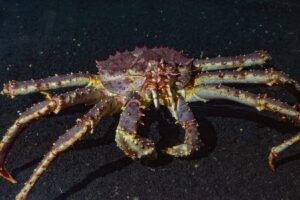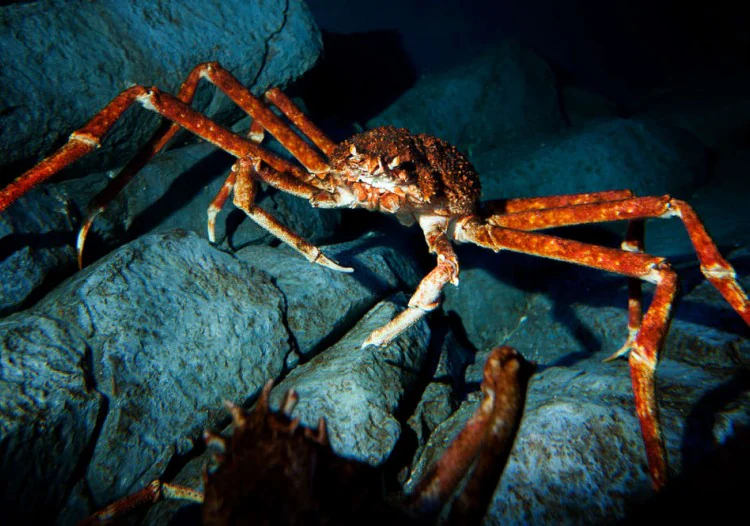The world beneath the surface of our oceans holds a treasure trove of fascinating creatures, and among them, one truly stands out as the king of crustaceans – the mighty King Crab.
In this informative blog post, we embark on an exploration of this remarkable marine species, delving into its captivating features, habitat, life cycle, and significance in marine ecosystems. Join us on a journey into the depths of the ocean to uncover the mysteries of the King Crab.
The King Crab’s Anatomy and Physical Characteristics
Impressive Size and Weight
The King Crab, scientifically known as Paralithodes camtschaticus, is renowned for its impressive size and remarkable weight. As one of the largest crustaceans in the world, these crabs can reach truly astonishing dimensions. Typically, a fully grown King Crab boasts a leg span that extends up to 5 feet (1.5 meters) or more, with a body size to match. Their weight can vary, but they often tip the scales at 10 to 15 pounds (4.5 to 6.8 kilograms), and occasionally even more.
The sheer size and weight of this specie make them a striking presence in their natural habitat, which primarily includes the cold, deep waters of the North Pacific Ocean. Their substantial build is not only a testament to their longevity but also to their incredible adaptability in the challenging underwater environment they call home.
Iconic Appearance with Large, Powerful Claws
One of the most iconic features of the King Crab is its formidable set of large, powerful claws. These claws, also known as chelae, are asymmetrical, with one being significantly larger and heavier than the other. The larger claw is adapted for crushing and cutting, while the smaller claw is more dexterous and used for more delicate tasks, such as handling food.
These impressive claws are not just for show; they are essential tools for the King Crab’s survival. They use them for hunting, breaking open shells of mollusks and other crustaceans, and defending themselves against predators. The strength of their claws is awe-inspiring, capable of exerting immense pressure, which allows them to crack open shells with ease.
Exoskeleton and Unique Coloration
This ocean animal possess an exoskeleton that plays a crucial role in protecting their soft inner body from the harsh marine environment. This exoskeleton is made of a tough, chitinous material that provides both strength and flexibility. It consists of segments that are connected, allowing the crab to move with a degree of agility despite its substantial size.
One of the most distinctive aspects of the King Crab’s appearance is its unique coloration. They sport a striking reddish-brown to deep burgundy color, with hints of blue and white on their limbs. This coloration not only aids in camouflage against predators and prey but also makes them stand out in their frigid oceanic habitat.

Habitat and Distribution
Exploring the King Crab’s Preferred Environments
This crab specie are well-known for their preference for cold, deep-sea environments. Their natural habitat is primarily found in the northern reaches of the Pacific Ocean, particularly in the Bering Sea, the Gulf of Alaska, and the Aleutian Islands. These regions provide the ideal conditions for King Crabs to thrive.
- Cold Waters: King Crabs are cold-water crustaceans, and they are typically found in waters with temperatures ranging from 32 to 50 degrees Fahrenheit (0 to 10 degrees Celsius). These chilly waters are essential for their survival as they are adapted to withstand the extreme cold.
- Deep Ocean Floors: King Crabs are often found at depths ranging from 200 to 2,000 feet (60 to 600 meters) below the surface. They prefer the ocean floor, where they can scavenge for food and seek shelter in rocky crevices.
- Substrate and Shelter: King Crabs are known to inhabit areas with a rocky substrate, which provides ample hiding places and opportunities for protection against predators. They are also attracted to areas with an abundance of food sources, such as mollusks, clams, and other small marine creatures.
- Migration Patterns: King Crabs exhibit seasonal migration patterns, moving to deeper waters during the winter months and shallower regions during the summer. This behavior is often driven by temperature and food availability.
Global Distribution and Notable Regions
While King Crabs are most famously associated with the cold waters of the North Pacific, they can also be found in other parts of the world, although they are less common. Notable regions of global distribution include:
- Northeast Atlantic: Some species of this ocean animal, such as the Red King Crab (Paralithodes camtschaticus), have been introduced to the Barents Sea in the northeast Atlantic. They were originally brought there as part of a crab fisheries development program.
- Southern Hemisphere: King Crabs can also be found in the southern hemisphere, with species like the Southern King Crab (Lithodes santolla) inhabiting the waters off the southern coast of South America, particularly in Chilean and Argentinean waters.
- Russian Far East: The Russian Far East, including the Sea of Okhotsk and the Kamchatka Peninsula, is another notable region for King Crab populations. This area is known for its rich marine biodiversity.
- Alaskan Waters: The Alaskan waters, particularly the Bering Sea, are among the most prolific King Crab habitats in the world. This region supports large commercial fisheries that harvest King Crabs for their meat, which is considered a delicacy.
Video Credit – Slice
Ecological Significance
Role in Marine Food Webs
King Crabs play a significant role in marine food webs, particularly in the ecosystems where they are naturally abundant. Their ecological significance can be understood in several ways:
- Predation: King Crabs are opportunistic predators, feeding on a variety of prey, including clams, snails, sea urchins, and other small marine creatures. They help control the populations of these organisms, preventing overgrazing on kelp forests and seafloor communities.
- Carrion Feeders: King Crabs are also scavengers, consuming dead and decaying organic matter on the seafloor. Their role as carrion feeders contributes to nutrient cycling in marine ecosystems.
- Prey for Predators: King Crabs themselves serve as a food source for various marine predators, including fish, octopuses, and larger crustaceans. Their availability as prey helps support higher trophic levels in the food chain.
- Habitat Engineers: Their burrowing activities can modify the substrate of the seafloor, creating crevices and small burrows that offer shelter to other organisms, such as small fish and invertebrates.
Impact of King Crab Population Fluctuations
The population fluctuations of King Crabs can have far-reaching effects on marine ecosystems and human communities:
- Ecosystem Effects: Large fluctuations in King Crab populations can lead to changes in the abundance and distribution of their prey species. When populations decline of this ocean animal, their prey may proliferate, leading to overgrazing of kelp forests and seafloor communities. Conversely, when King Crab populations increase, their predation can keep prey populations in check.
- Economic Impact: Commercial fisheries targeting King Crabs are highly dependent on their population sizes. A decline in King Crab populations can have economic repercussions for fishing communities that rely on these valuable resources.
- Management Challenges: Managing King Crab populations can be challenging due to their cyclical nature and sensitivity to environmental factors. Fisheries management often needs to adapt to these fluctuations, implementing measures such as quotas and seasonal closures to protect populations during periods of low abundance.
Conservation Concerns about King Crabs
While King Crabs are not typically considered endangered or threatened, there are several conservation concerns related to their populations and habitats:
- Overfishing: Intensive commercial fishing of King Crabs can lead to overfishing if not properly managed. Overharvesting can deplete local populations and disrupt marine ecosystems.
- Habitat Destruction: Bottom trawling and other destructive fishing practices can damage the seafloor habitats where King Crabs reside, impacting not only the crabs but also other species that depend on these environments.
- Climate Change: King Crabs are sensitive to changes in ocean temperature and chemistry. Climate change can alter their distribution and behavior, potentially leading to shifts in their populations and impacts on other species.
- Invasive Species: In some regions, these crabs have been introduced as invasive species, competing with native species and altering local ecosystems.
FAQs about King Crabs
- What’s the Difference Between King Crabs and Other Crabs?
King crabs stand out due to their size and spiky appearance. They’re much larger than most other crab species, and their long, spindly legs are a distinctive feature.
- Are King Crabs Endangered?
While King crabs are not currently considered endangered, careful management is essential to prevent overfishing. Sustainable practices help maintain their populations.
- How Should I Cook King Crab Legs?
Cooking King crab legs is a breeze. Simply steam or boil them for around 8-10 minutes per pound. Serve with melted butter and enjoy!
- What’s the Best Season to Enjoy Fresh King Crab?
The prime season for fresh King crab is from October to January when they are at their plumpest and most flavorful.
- Can You Freeze King Crab?
Yes, you can freeze King crab for later use. Wrap them tightly in plastic or foil before freezing to maintain their freshness.
- What’s the Ideal Serving Size for King Crab Legs?
A good rule of thumb is to serve 1 to 1.5 pounds of King crab legs per person for a satisfying meal.
Conclusion
In the depths of our oceans, the King Crab reigns supreme as a majestic and captivating creature. Its colossal size, powerful claws, and intricate life cycle make it a true wonder of the marine world. This blog post has shed light on the anatomy, habitat, life cycle, ecological significance, and economic importance of the King Crab, showcasing its vital role in the intricate web of life beneath the waves.
As we conclude our journey into the realm of the this specie, let us not forget the importance of conservation efforts to protect this extraordinary species and the delicate balance of the oceans it contributes to. As we continue to learn and appreciate the wonders of our natural world, may the King Crab inspire us to explore, conserve, and respect the diverse ecosystems of our planet’s oceans.
UP NEXT
The Portuguese Man of War: A Beautiful but Dangerous Jellyfish
Stonefish: Masters of Camouflage and Venom



